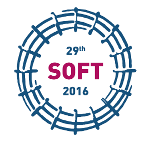Speaker
Wolfgang Krauss
(Institute for Applied Materials)
Description
Joining of armor material tungsten to other alloys and especially to copper components which will act as heat sinks in divertor application showed lacks due to the restricted miscibility of tungsten and copper. This negative behavior leads to bad or missing metallurgical W – Cu reactions with the consequence of reduced mechanical stability or high risks of cracking if any joining was realized. Introducing adapted interlayers can overcome these limitations if they exhibit some extended miscibility with both parts to be joined as, e.g., the elements Fe, Cr, Ni or Pd.
Electrochemical plating was chosen as deposition technology for such reactive interlayers and the plating characteristics of preferably Pd on W and Cu was analyzed to obtain adherent and industrially applicable coatings. The electrochemical plating was performed applying an aqueos Pd electrolyte based on an ammonia complex. Based on this evaluated plating parameters demonstrators were processed with a 10 µm thick reactive Pd interlayer and joined by diffusion bonding. Their metallurgical behavior was characterized in dependence on processing temperature, reaction time and applied pressing load. Beyond of analyzing the reactive joining process the fabricated joints were mechanically qualified by shear testing. Cracking of the joints never appeared at the boundary of interlayer to W which was the critical zone of pure W – Cu connections. The demonstrators revealed reasonable and applicable shear strength of around 100 MPa. The observed shear strength values and formed microstructures in the joining zone will be displayed and discussed in dependence on the applied processing parameters. The developed bonding process by applying electrochemically plated interlayers has proven to be a reliable tool with industrial application potential.
Co-authors
Julia Lorenz
(Institute for Applied Materials, Karlsruhe Institute of Technology, Eggenstein-Leopoldshafen, Germany)
Jurgen Konys
(Institute for Applied Materials, Karlsruhe Institute of Technology, Eggenstein-Leopoldshafen, Germany)
Wolfgang Krauss
(Institute for Applied Materials, Karlsruhe Institute of Technology, Eggenstein-Leopoldshafen, Germany)

